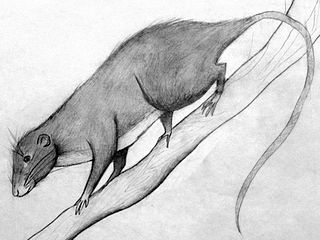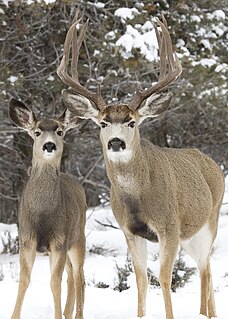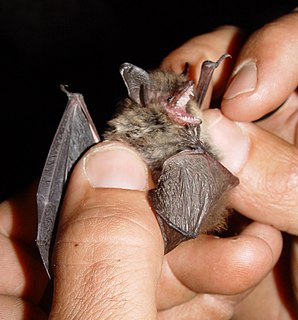 W
WThe Amazon bamboo rat is a species of spiny rat from the Amazon Basin of South America. It is also referred to as coro-coro, Toró, Rato-do-Bambú, or Rata del Bambú in different parts of its range. The bamboo rat prefers to reside in areas of dense vegetation, such as clumps of bamboo or in the canopy. It is an arboreal browser, consuming primarily leaves and spending much of its time off the ground. Because the Amazon bamboo rat spends most of its time in heavily forested areas, it is difficult to observe, and not much is known about its habits.
 W
WThe Amazon river dolphin, also known as the boto, bufeo or pink river dolphin, is a species of toothed whale classified in the family Iniidae. Three subspecies are currently recognized: I. g. geoffrensis, I. g. boliviensis and I. g. humboldtiana while position of Araguaian river dolphin within the clade is still unclear. The three subspecies are distributed in the Amazon basin, the upper Madeira River in Bolivia, and the Orinoco basin, respectively.
 W
WThe Amazonian brown brocket, also known as the small brown brocket, is a small species of deer that is almost entirely restricted to South America. It is known from Panama, Colombia, Venezuela, Guyana, Suriname, French Guiana, eastern Ecuador, eastern Peru, Brazil and possibly northern Bolivia. Habitats it is found in include primarily nonflooded Amazonian tropical rainforest, and locally also tropical deciduous forest and xeric shrublands, at altitudes up to 1,500 metres (4,900 ft). However, reports from the latter habitats may actually represent M. gouazoubira.
 W
WThe common bent-wing bat, Schreibers's long-fingered bat, or Schreibers's bat refers to a species of insectivorous bat, a taxonomic complex of subspecies and probably several species in the family Miniopteridae currently named as Miniopterus schreibersii. They appear to have dispersed from a subtropical origin and distributed throughout the southern Palearctic, Ethiopic, Oriental, and Australian regions. In Europe, it is present in the southern half on the continent from Iberia to the Caucasus, with the largest populations found in the warmer Mediterranean area. The common and scientific names honor Carl Franz Anton Ritter von Schreibers.
 W
WBechstein's bat is a species of vesper bat found in Europe and western Asia, living in extensive areas of woodland.
 W
WBlainville's beaked whale, or the dense-beaked whale, is believed to be the widest ranging mesoplodont whale. The French zoologist Henri de Blainville first described the species in 1817 from a small piece of jaw — the heaviest bone he had ever come across — which resulted in the name densirostris. Off the northeastern Bahamas, the animals are particularly well documented, and a photo identification project started sometime after 2002.
 W
WThe collared brown lemur, also known as the red-collared brown lemur or red-collared lemur, is a medium-sized strepsirrhine primate and one of twelve species of brown lemur in the family Lemuridae. It is only found in south-eastern Madagascar. Like most species of lemur, it is arboreal, moving quadrupedally and occasionally leaping from tree to tree. Like other brown lemurs, this species is cathemeral, lives in social groups, primarily eats fruit, exhibits sexual dichromatism, and does not demonstrate female dominance. The species is listed as Endangered by the International Union for Conservation of Nature (IUCN) and is threatened primarily by habitat loss.
 W
WDaubenton's bat or Daubenton's myotis is a Eurasian bat with rather short ears. It ranges from Ireland to Japan (Hokkaido) and is considered to be increasing its numbers in many areas.
 W
WFerreira's spiny tree-rat, Mesomys hispidus, is a spiny rat species from South America. It is found in Bolivia, Brazil, Colombia, Ecuador, French Guiana, Guyana, Peru, Suriname and Venezuela.
 W
WThe hairy Atlantic spiny rat, Trinomys setosus, is a spiny rat species from South America. It is endemic to Brazil.
 W
WHeteromys is a genus of rodents in the family Heteromyidae, commonly known as spiny pocket mice. It is the only extant genus in the subfamily Heteromyinae which also includes the extinct genera Diprionomys and Metaliomys. Heteromys was recently enlarged by inclusion of the members of formerly recognized heteromyine genus Liomys, which was found to be paraphyletic.
 W
WThe koala or, inaccurately, koala bear is an arboreal herbivorous marsupial native to Australia. It is the only extant representative of the family Phascolarctidae and its closest living relatives are the wombats, which are members of the family Vombatidae. The koala is found in coastal areas of the mainland's eastern and southern regions, inhabiting Queensland, New South Wales, Victoria, and South Australia. It is easily recognisable by its stout, tailless body and large head with round, fluffy ears and large, spoon-shaped nose. The koala has a body length of 60–85 cm (24–33 in) and weighs 4–15 kg (9–33 lb). Fur colour ranges from silver grey to chocolate brown. Koalas from the northern populations are typically smaller and lighter in colour than their counterparts further south. These populations possibly are separate subspecies, but this is disputed.
 W
WKuhl's pipistrelle is a species of vesper bat that lives over large areas of North Africa, southern Europe and Western Asia. It can be found in temperate forests, subtropical or tropical dry shrubland, Mediterranean-type shrubby vegetation, temperate grassland, rural gardens, and urban areas.
 W
WThe lesser noctule, Leisler's bat or the Irish bat, is a species of insectivorous bat belonging to the vesper bat family, Vespertilionidae. The species was named to honour the naturalist Johann Philipp Achilles Leisler
 W
WFerreira's spiny tree-rat, Mesomys hispidus, is a spiny rat species from South America. It is found in Bolivia, Brazil, Colombia, Ecuador, French Guiana, Guyana, Peru, Suriname and Venezuela.
 W
WThe mountain beaver is a North American rodent. It is the only living member of its genus, Aplodontia, and family, Aplodontiidae. It should not be confused with true North American and Eurasian beavers, to which it is not closely related.
 W
WThe mule deer is a deer indigenous to western North America; it is named for its ears, which are large like those of the mule. Two subspecies of mule deer are grouped into the black-tailed deer.
 W
WNatterer's bat is a European vespertilionid bat with pale wings. It has brown fur tending to greyish-white on its underside. It is found across most of the continent of Europe, parts of the Near East and North Africa. It feeds on insects and other invertebrates which it catches on the wing or pursues on the ground.
 W
WThe plains viscacha or plains vizcacha is a species of viscacha, a rodent in the family Chinchillidae. It is the only living species within the genus Lagostomus. It is found in Argentina, Bolivia, and Paraguay. The plains viscacha is the largest species in its family. They construct elaborate burrows that house successive colonies for decades.
 W
WThe red-necked wallaby or Bennett's wallaby is a medium-sized macropod marsupial (wallaby), common in the more temperate and fertile parts of eastern Australia, including Tasmania. Red-necked wallabies have been introduced to several other countries, including New Zealand, the United Kingdom, Ireland, the Isle of Man, France and Germany.
 W
WThe southeastern pocket gopher is a species of pocket gopher that is native to the southeastern United States. It occurs in Alabama, Georgia, and Florida, where it is the only pocket gopher.
 W
WThe southern white rhinoceros or southern square-lipped rhinoceros, is one of the two subspecies of the white rhinoceros. It is the most common and widespread subspecies of rhinoceros.
 W
WThe tammar wallaby, also known as the dama wallaby or darma wallaby, is a small macropod native to South and Western Australia. Though its geographical range has been severely reduced since European colonization, the tammar wallaby remains common within its reduced range and is listed as "Least Concern" by the International Union for Conservation of Nature (IUCN). It has been introduced to New Zealand and reintroduced to some areas of Australia where it had been previously eradicated. Skull differences distinguish tammar wallabies from Western Australia, Kangaroo Island, and mainland South Australia, making them distinct population groups or possibly different subspecies.
 W
WThe hairy Atlantic spiny rat, Trinomys setosus, is a spiny rat species from South America. It is endemic to Brazil.
 W
WThe western grey kangaroo, also referred to as a western grey giant kangaroo, black-faced kangaroo, mallee kangaroo, and sooty kangaroo, is a large and very common kangaroo found across almost the entire southern part of Australia, from just south of Shark Bay through coastal Western Australia and South Australia, into western Victoria, and in the entire Murray–Darling basin in New South Wales and Queensland.
 W
WThe whiskered bat and related species, are small European bats with long fur. Although uncommon, M. mystacinus is often found around human habitation and around water; it is similar to Brandt's bat Myotis brandtii, from which it was distinguished as a separate species only in 1970.
 W
WThe white rhinoceros or square-lipped rhinoceros is the largest extant species of rhinoceros. It has a wide mouth used for grazing and is the most social of all rhino species. The white rhinoceros consists of two subspecies: the southern white rhinoceros, with an estimated 19,682–21,077 wild-living animals in the year 2015, and the much rarer northern white rhinoceros. The northern subspecies has very few remaining individuals, with only two confirmed left in 2018, both in captivity. Sudan, the world's last known male northern white rhinoceros, died in Kenya on 19 March 2018.
 W
WXerus erythropus is a species of squirrel native to Africa. It was first described by Geoffroy in 1803, but the original publication may be unavailable, so that the binomial authority is today more often cited as "Desmarest, 1817". There are six subspecies. It is a moderately large ground squirrel with sandy-brown or dark-brown fur with a white lateral stripe and whitish underparts. Adults live alone or in pairs in a simple burrow with a central nest, foraging, mostly on the ground, for seeds, nuts and roots, and caching excess food under stones. This is a common species with a wide range and the International Union for Conservation of Nature has rated its conservation status as being of "least concern".